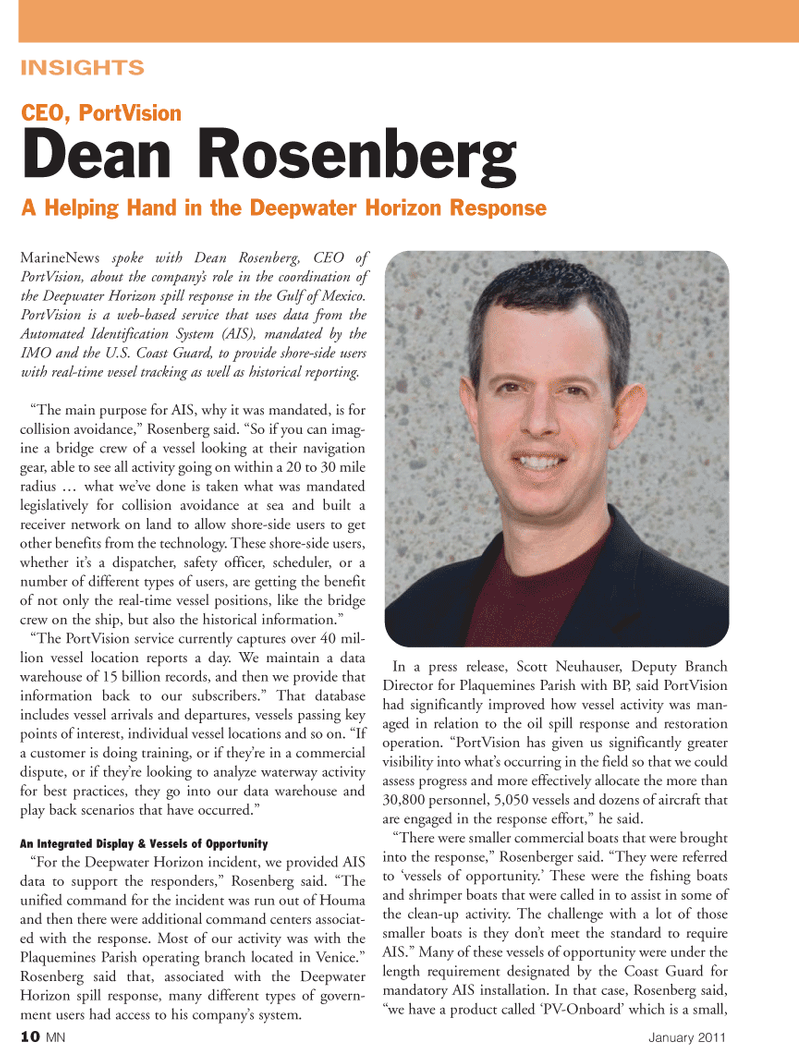
Page 10: of Marine News Magazine (January 2011)
Vessel Construction & Repair
Read this page in Pdf, Flash or Html5 edition of January 2011 Marine News Magazine
MarineNews spoke with Dean Rosenberg, CEO of
PortVision, about the company’s role in the coordination of the Deepwater Horizon spill response in the Gulf of Mexico.
PortVision is a web-based service that uses data from the
Automated Identification System (AIS), mandated by the
IMO and the U.S. Coast Guard, to provide shore-side users with real-time vessel tracking as well as historical reporting. “The main purpose for AIS, why it was mandated, is for collision avoidance,” Rosenberg said. “So if you can imag- ine a bridge crew of a vessel looking at their navigation gear, able to see all activity going on within a 20 to 30 mile radius … what we’ve done is taken what was mandated legislatively for collision avoidance at sea and built a receiver network on land to allow shore-side users to get other benefits from the technology. These shore-side users, whether it’s a dispatcher, safety officer, scheduler, or a number of different types of users, are getting the benefit of not only the real-time vessel positions, like the bridge crew on the ship, but also the historical information.” “The PortVision service currently captures over 40 mil- lion vessel location reports a day. We maintain a data warehouse of 15 billion records, and then we provide that information back to our subscribers.” That database includes vessel arrivals and departures, vessels passing key points of interest, individual vessel locations and so on. “If a customer is doing training, or if they’re in a commercial dispute, or if they’re looking to analyze waterway activity for best practices, they go into our data warehouse and play back scenarios that have occurred.”
An Integrated Display & Vessels of Opportunity “For the Deepwater Horizon incident, we provided AIS data to support the responders,” Rosenberg said. “The unified command for the incident was run out of Houma and then there were additional command centers associat- ed with the response. Most of our activity was with the
Plaquemines Parish operating branch located in Venice.”
Rosenberg said that, associated with the Deepwater
Horizon spill response, many different types of govern- ment users had access to his company’s system.
In a press release, Scott Neuhauser, Deputy Branch
Director for Plaquemines Parish with BP, said PortVision had significantly improved how vessel activity was man- aged in relation to the oil spill response and restoration operation. “PortVision has given us significantly greater visibility into what’s occurring in the field so that we could assess progress and more effectively allocate the more than 30,800 personnel, 5,050 vessels and dozens of aircraft that are engaged in the response effort,” he said. “There were smaller commercial boats that were brought into the response,” Rosenberger said. “They were referred to ‘vessels of opportunity.’ These were the fishing boats and shrimper boats that were called in to assist in some of the clean-up activity. The challenge with a lot of those smaller boats is they don’t meet the standard to require
AIS.” Many of these vessels of opportunity were under the length requirement designated by the Coast Guard for mandatory AIS installation. In that case, Rosenberg said, “we have a product called ‘PV-Onboard’ which is a small,
INSIGHTS
CEO, PortVision
Dean Rosenberg
A Helping Hand in the Deepwater Horizon Response 10 MN January 2011

 9
9

 11
11
